By Patrick O’Donnell
In the early morning of June 6, 1944, LCA 668 (Landing Craft, Assault), carrying First Sergeant Len Lomell, Staff Sergeant Jack Kuhn, and most of the 2nd Platoon, 2nd Ranger Battalion, cut through the choppy, green waters of the English Channel.
As the men poked their helmets out of the top of the boat, they were looking at what would be center stage of one of the greatest amphibious landings in history. They saw, heard, and felt the intense bombardment on the shore, demonstrating the full might of the American and British battleships, destroyers, and bombers.
The sight mesmerized the 22 young Rangers. Through the smoke and fire, the men watched as scores of rockets from a naval barge ignited and streaked through the air.
Not far behind Lomell, LCA 858 carried Lieutenant George Kerchner and his 1st Platoon. Massive shells from the battleships passed directly over their heads.
“We were close enough to hear and feel some of the muzzle blasts,” Kerchner later remarked. “One of the rocket-firing craft that was near Omaha Beach fired their rockets. This was also a terrifying thing; I think there were a thousand or more rockets on these landing craft, and they fired in salvos of maybe 10 or 15 at a time. It was just one continuous sheet of fire.”
“How can anybody live through that?” thought Kerchner.
As the small flotilla of British-crewed craft carrying the Rangers of Force A plowed through waves of the channel, something seemed off. In LCA 668, Lomell knew it. Through the mist and spray, the dark, rocky cliffs of what appeared to be Pointe et Raz de la Percée came into view.
Len Lomell turned to his close friend Jack Kuhn. “Hey, Jack! Look at this. That’s not the Pointe. That’s C Company’s target.”
Kuhn nodded.
Lomell moved across the crowded landing craft towards the British coxswain who was piloting the craft and asked him if they were headed in the right direction. The coxswain nodded affirmatively.
Lomell pressed the issue. “Are you sure you are right about this?”
From the photos that Lomell looked at during the training exercise, he was sure the 10 landing craft, three DUKWs, and other small boats in Force A were at least two miles off course from Pointe du Hoc and heading in the wrong direction.
In the dense smoke and haze, guiding the flotilla in ML-304 (Motor Launch), Lieutenant Colin Beever of the Royal Navy Volunteer Reserve was in fact dangerously off course. In Beever’s defense, the new 970 radar equipment was at fault. Introduced a month earlier, the equipment tested well in controlled settings but failed on D-Day.
Dog Company and the rest of Force A were mistakenly heading toward Pointe et Raz de la Percée, Force B’s objective. The error in navigation would change the course of history by putting Force A nearly 40 minutes behind schedule in reaching their target. About 100 yards from what was clearly Pointe et Raz de la Percée, Lt. Col. James Earl Rudder, commanding the 2nd Ranger Battalion, realized the error and ordered Beever to change course and turn west toward Pointe du Hoc.
The operation’s entire timetable was now blown. The follow-on force known as Force C—which included Able and Baker companies and some elements of Headquarters Company of the 2nd Ranger Battalion and Lt. Col. Max Schneider’s Fifth Ranger Battalion—would not be heading to Pointe du Hoc because they never received the appropriate radio signal from Force A.
Hence, Force C headed to its second objective, Omaha Beach. Dog Company, along with the rest of Force A, was now on its own and outgunned, heading straight for Pointe du Hoc with no follow-on reinforcements.
Late, but back on course, the DUKWs and assault craft of Ranger Force A raced towards Pointe du Hoc. With the flotilla just a few hundred yards from the Norman coast, the Germans peppered the landing craft with machine-gun fire, hitting several men.
As bullets flew by, fierce waves pounded the incoming landing craft, and the icy froth of the churning channel waters soaked the men, who frantically bailed water to avoid sinking.
Most of the men became seasick. The Army had issued them paper bags, but no one had time to use them. “We were taking on water,” Men were throwing up as we were bailing seawater out of the landing craft. I know I did.”
The turbulent channel waves relentlessly lashed LCA 860, nearly capsizing the craft carrying Captain Harold K. “Duke” Slater, Lieutenant Morton McBride, Sergeant Antonio J. Ruggiero, Technician 5th Class Raymond J. Riendeau, and 17 other men from Dog Company. With his boat a mere 20 yards in front of them, an anxious Lomell stared back at The Duke. The roar of the waves crashing into the boats drowned out the dull hum of the craft’s motor.
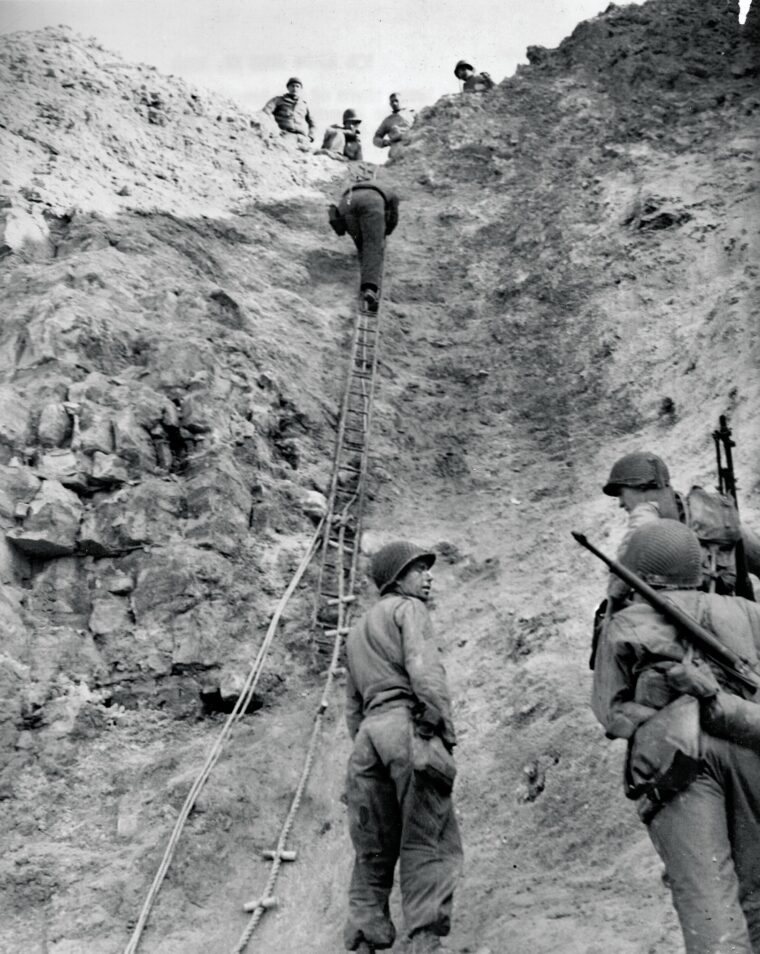
Inside the British-made boat, Slater and his men feverishly bailed water with their helmets to keep from drowning. Waves from the channel cascaded over the sides of the craft, filling the boat, and drenching everyone inside. They were sinking, and Force A’s supply boat was also taking on water.
Remarkably, despite the swirling seas and incoming German fire, the men were focused on a standing bet they had made about who would reach shore first. One hundred dollars would go to the winners. Spawned at Camp Forrest, Tennessee, the Rangers’ highly competitive ethos and winning spirit permeated their every bone and fiber. Lomell and the men of LCA 668 were determined to win.
Focused on being the first boat to land on shore and not realizing the deadly force of the channel’s currents, several men on board Lomell’s boat and Kerchner’s landing craft cheered and applauded when they saw Duke Slater’s craft going down. Lomell remembers some of the men saying, “That’s one less group we have to compete with. We’ve only got Kerchner now.”
Over a half an hour late, Rudder’s flotilla, minus Slater’s foundering LCA and the Rangers’ supply boat, headed for the eastern side of Pointe du Hoc. The original plan called for Dog Company to land on the western side of the Pointe, but Rudder, in an effort to keep everyone together, ordered all craft to land on the eastern side of the 500-yard rocky peninsula, landing at approximately 7:08 am, nearly 40 minutes behind schedule.
Shortly after landing, communications officer Lieutenant James Eikner signaled “Tilt,” indicating that Force A was behind schedule and Schneider’s Force C should pursue their secondary objective, Omaha Beach. Mysteriously, the radios were not operating properly.
Acknowledgement was “receipted,” according to Eikner, but Schneider’s records show that they never got his message; the only message received by the 5th was a word that “sounded like Charlie.” Even the guide-crafts’ radios were inoperable and unable to send the same message.
These two bizarre circumstances—Beever’s navigation error and the inoperable radios—created an auspicious chain of events that resulted in Force C landing on Omaha Beach instead of their primary objective, Pointe du Hoc.
After waiting an extra 10 minutes, with still no message from Rudder affirming his landing on Pointe du Hoc, Schneider redirected his boats to their secondary target, Omaha Beach. This alteration in Schneider’s plans changed the outcome of the invasion by putting his men exactly where they were needed, though the initial wave sustained heavy casualties.
The first elements of Force C to reach their objective, “Dog Green” beach, were craft bearing A, B, and Headquarters Companies of the 2nd Ranger Battalion, which landed on a shoulder of the Vierville Draw, where the Germans constructed a deadly Widerstandsnest or “Resistance Nest.”
In a bloody scene immortalized in the movie Saving Private Ryan, waves of men from the 2nd Ranger Battalion were cut down in a kill zone containing numerous bunkers with enfilading machine-gun fire. German antitank guns and mortars mercilessly fired upon the incoming Rangers, who later dubbed the area “The Devil’s Garden.”
Seeing Dog Green was shut down and the enormous losses A, B, and Headquarters Companies were taking and being waved off by landing control on the beach, Schneider, a veteran of Ranger landings in Africa, Sicily and Italy, ordered the 5th to land on a quieter beach known as Dog White, located next to Dog Green beach. (Elements of Force C landed on the boundary between Green and White beaches. Captain Edgar L. Arnold’s B Company landed on Dog Green and the 5th’s A Company and the HQ boat on Dog White. Other portions of the 5th landed to the east on Dog Red.)
The extra battalion landing in the right place at exactly the right time proved crucial to the American breakout from Omaha Beach. Near the seawall on the beach, men of Schneider’s battalion ran into Brig. Gen. Norman Cota, assistant division commander of the 29th Infantry Division, who uttered the famous command to the men of the 5th: “Rangers, lead the way!” With that, the 5th broke out of the beachhead and flanked the German defenses at Omaha.
Force B’s attack on Pointe et Raz de la Percée would also prove critical. Using “bayonets and their bare hands,” the men of Charlie Company scaled the cliffs and took out numerous German mortar positions that were zeroed in on Omaha Beach.
At Pointe du Hoc, the delay of Rudder’s Force A had given the Germans precious time to recover from the initial shore bombardment and contest the landing. The original Allied plan called for the shore bombardment to cease at 6:30 am, only minutes before the Rangers were supposed to begin assaulting the cliffs. (Beever’s navigation error likely saved the lives of many of Rudder’s men. Their delay in landing on Pointe du Hoc prevented them from being hit by B-26 bombers, which bombarded the Pointe 20 minutes late (between 6:25 and 6:45 am––the exact time when Force A was scheduled to land). But now, the Germans were ready and waiting for Dog Company’s frontal assault, due to the extra 30 minutes afforded by Force A’s late arrival.
Nineteen-year-old German Private Wilhelm Kirchhoff of 2nd Battalion, Werfer-Regiment 84 vividly described the scene: “The American landing craft were coming from the [east] and were fully loaded with men and material. When they arrived, the waves were very high and the little boats were thrown about violently. Once they hit the beach, the ramps dropped and the men charged out.
“We received no orders to fire, but the enemy was there below us so we fired! At that moment we were nervous but active. We fired from the edge with our machine guns…. We targeted the Americans as they exited the landing craft. They were firing up [at us] but were out in the open.”
Kirchhoff and the other members of his regiment were dug in near a bunker on the eastern edge of the Pointe. All told, about 120 of them, including 15 men from the Werfer Regiment, took full advantage of their superior position and firepower to resist the Rangers’ landing.
“From the Pointe we started throwing grenades until we couldn’t see them anymore,” recalled Rudolf Karl, an artillerist NCO atop the Pointe. “For the Americans down on the beach, the effect would have been devastating. They had no protection there at all.”
Machine-gun bullets slapped the water in front of the Rangers’ incoming boats and “potato-masher” grenades rained down on the Americans. According to Kirchhoff, even “radio and telephone operators in the trenches … fired with their weapons. I continued firing my machine gun but also witnessed grenades being thrown. There were also mortars ahead of me [that] fired onto the beach below. I stood up from my trench, picked up my weapon, and kept firing, uncertain how many times I fired.”
One Ranger recalled the fury of the German defense: “As we approached these cliffs, all hell broke loose. We could hear the zing of the bullets, and a few artillery shells being lobbed in …. [We] heard the splatter of the machine guns and the German riflemen up on the edge of this cliff shooting down at us. There was a Ranger sitting across from me who was shot in the chest. A Stars and Stripes photographer vomited on me.”
Fittingly, Rudder’s craft hit the 30-yard strip of rocky beach first. Bombs and artillery shells from the Allied ships had blasted away part of the cliff face where it met the narrow beach, creating massive underwater craters near the base of the peninsula.
As Jack Kuhn’s landing craft approached Rudder’s boat near the rocky shore, Kuhn looked up at the ominous precipice. Momentarily stunned by what he saw, his Thompson slipped out of his hand and into the several inches of seawater and floating vomit that filled the bottom of the craft.
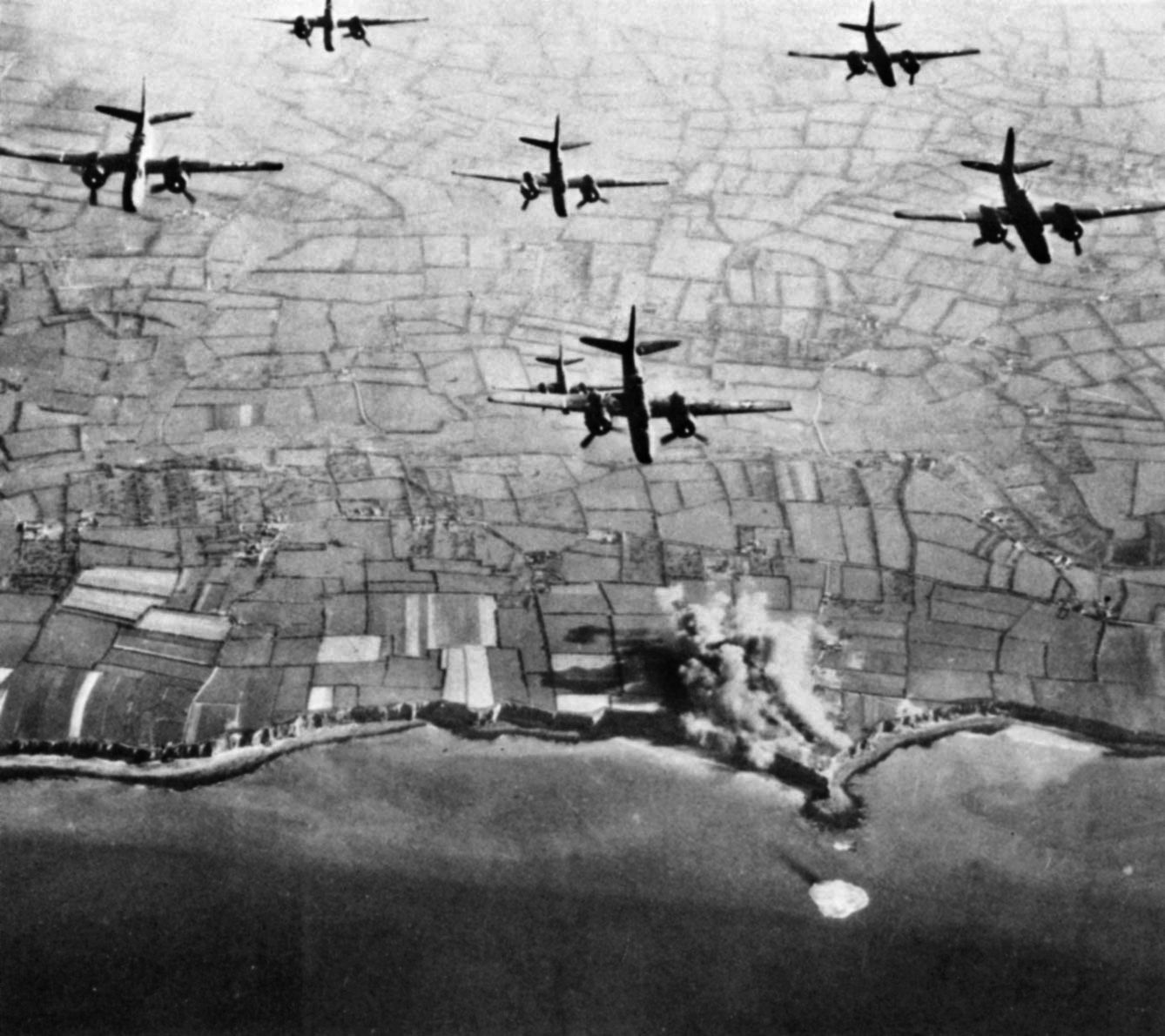
Inside the cramped boat, Kuhn turned to Corporal Sheldon Bare and snapped, “Bare, I lost my Thompson!”
Bare reached down into the filthy, brackish water and fished out Kuhn’s weapon. “Here you go, Jack,” he said as the boat neared the shore.
From his position on LCA 668, Lomell ordered the grapnel rockets fired at the cliff. Ironically, “the grapnels seemed like a lifeline, but were just as likely to lead the men to death as to life. Climbing the ropes would take the men out of the frying pan of German machine-gun bullets and potato mashers landing on the beach and into the fire of the battle on top of the cliff.”
Several yards away from Lomell, Fox Company Commander Captain Otto Masny tensely estimated when to fire the grapnels from his boat. He noticed several craft had fired too soon, causing the rockets to fall short and miss the cliff. Masny barked at the British coxswain guiding his craft to the Pointe, “Don’t fire those things until I give the word! We’ve got plenty of time.”
To hammer home Masny’s order, Lieutenant Richard A. Wintz pulled out his .45. “You drop those gates or let those charges go before I give the order, and I’ll put a bullet in your head.”
On board LCA 668, the loud explosion caused by the coxswain’s firing the grapnel rockets jarred Lomell as he stared at the cliffs of Pointe du Hoc looming in front of him.
SPLASH!
The ramp dropped, and the coxswain barked, “All right, everybody out!”
Lomell’s boat had stopped several yards short of the shoreline. “We had amphibious DUKWs but [there were] so many underwater craters they couldn’t get in too close to the cliff.”
Lomell led the group. As he stepped off the ramp, he completely disappeared from view. A massive underwater bomb crater had swallowed up the first sergeant. The icy water, just 42 degrees, rushed around him as he quickly submerged eight feet below the surface. Bullets pierced the silence underwater as he swam out of the crater and joined the other men, who had avoided the hazard.
“Ow!” Lomell felt a sudden sting of pain through his right side. A German machine-gun bullet barely missed his ribs and went through the fleshy portion of his torso. Not realizing where it came from, Lomell spun around and came face to face with Private Harry Fate.
“Harry, you son of a bitch. You shot me!”
Fate pleaded his innocence. “I didn’t do it! I didn’t try to kill you!”
“I was about to kill him for doin’ it,” Lomell admitted later. After all, Lomell had busted Fate from sergeant to private just a few weeks prior. After losing his stripes, Fate had made a veiled threat to Lomell: “That’s all right. You know all first sergeants get their due in combat. I’ll see you in combat.”
Breaking the standoff, Bill Geitz, Lomell’s medic, socked the first sergeant in the jaw and knocked him down, yelling, “Len, he didn’t do it! He didn’t do it!”
The altercation lasted only a few seconds before Lomell snapped out of his rage and focused on assaulting the cliff towering in front of his men.
Minutes later, George Kerchner’s LCA 858 touched down next to Lomell’s boat. Before the craft landed, Kerchner thought about the half-hour delay and felt an overwhelming sense of foreboding.
“Holy hell,” he thought, “someone made a hell of big mistake sending us in here. We’ll never get up there.”
Kerchner looked in front of him. Twenty feet of murky water stained with a reddish mixture of Ranger blood and clay from the cliffs lay between him and the shore. Kerchner looked back at his men, “OK, let’s go!”
As he turned back around, the green lieutenant slipped and found himself submerged in eight feet of water in the same shell hole Lomell had fallen into minutes earlier.
“Oh, hell, here we go!” he thought angrily as he “doggy paddled” to keep his head above the water. The men of 1st Platoon saw what happened and moved around the crater. “I remember being angry because I was soaked … wringing wet. I turned around and wanted to find someone to help me cuss out the British Navy for dumping me in this eight feet of water,” remembered Kerchner.
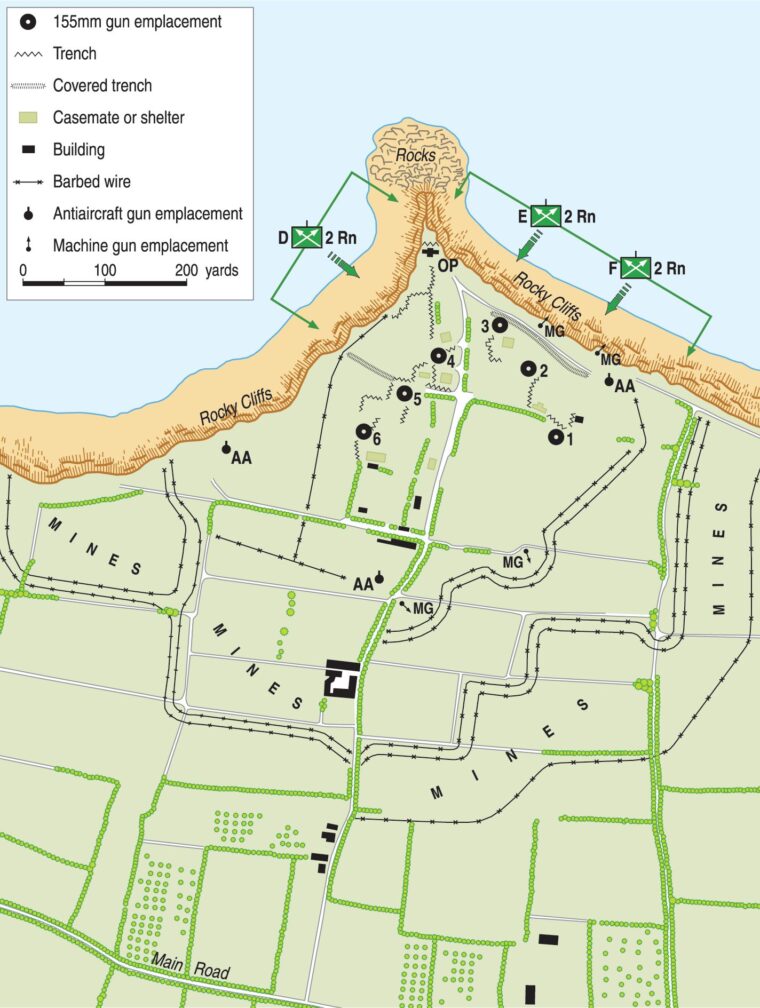
But the ripping sound of a German bonesaw MG 42 machine gun as it zeroed in on 1st Platoon silenced any cussing Kerchner intended to unload on the British coxswain. From the top of the cliff, the German soldiers relentlessly fired down on the incoming Americans.
As German machine gunner Kirchhoff related, “Until that moment, I had probably fired 10,000 rounds. I had switched barrels several times but the flash hider still sometimes got red hot.”
On the beach, a bullet ripped into Sergeant Francis Pacyga’s arm. The same bullet blew out the kneecap of Pfc. Lester Harris, causing him to drop his weapon. Kerchner, armed with just his .45, grabbed Harris’s discarded M1 and led his men to the side of the cliff.
Running about 25 yards down the beach, Kerchner found Rudder. Kerchner informed him that Duke Slater’s boat was missing and “presumed capsized,” so Kerchner now commanded Dog Company. Under heavy fire, Rudder turned to Kerchner and yelled, “Get the hell out of here and get up and climb that rope!”
As the men of Dog dashed toward the cliff, MG 42 machine-gun bullets kicked up the gravel around them. “I thought I was kicking up pebbles and dirt. But they were actually bullets that were hitting the sand and kicking up the dirt around me,” one Ranger explained.
Months of training kicked into gear. The men ran like rabbits towards the base and began to climb. Several Rangers returned fire as they rushed to the ropes, but the German defenders took their toll as more and more Rangers went down.
When Dog started climbing, Sheldon Bare fired at the Germans, but as the men neared the top, he ceased fire. “I stopped firing because I didn’t want to hit our men on top of the cliff,” recalled Bare.
Then it was Bare’s turn to make the hazardous climb. “The ropes were slippery, and the Germans were cutting them. (Some of the grapnels contained burning fuses, which deterred the Germans from cutting the ropes because they mistook them for explosives.) Some dropped grenades,” he remembered.
“Further to my left, I saw the grappling hooks that the Americans fired to the top of the cliff. But one of the artilleryman crawled forward and cut the rope,” recalled Kirchhoff, the German Werfer-Regiment private. “The Americans were unable to climb up. They remained on the beach but kept trying.”
Some of the men, like Private Sigurd Sundby from Dog Company, struggled with the ascent. “The rope was wet and kind of muddy; my hands just couldn’t hold. They were like grease, and I came sliding back down. I wrapped my foot around the rope and slowed myself up as much as I could, but my hands still burned.”
As Sundby slid back down the rope, he landed near another Ranger. “What’s the matter, Sundby, you chicken? Let me—I’ll show you how to climb.”
Corporal Wilbur K. “Bill” Hoffman described the confusion: “I was assigned a specific rope [and] to a specific [German] gun. I was supposed to do some specific damage. I had a big stick of C-2 in my pocket. I just grabbed a rope, and somebody yelled, ‘Hey, hey, that’s mine!’ They were firing down at us and throwing down potato-masher grenades, and they also cut some ropes. I don’t really know how we got up the cliff.”
As the 225 Rangers from Assault Force A crowded the tiny beach, machine guns, grenades, and small arms fire peppered them. Making the climb even more perilous, the Germans had also booby-trapped the cliff face with “roller mines.” (According to interviews with French civilians living in the area, the Germans had suspended numerous shells in intervals along the cliff face.) Precursors to the IEDs of today, roller mines were old French artillery shells suspended on wires. Cutting the wires would detonate the shells. Accounts suggest that the Germans detonated one shell, causing a landslide near Easy Company climbers.
Lomell soon realized the ropes his boat had fired at the cliff weren’t allowing the men to climb fast enough. He ordered the Rangers to assemble the four-foot metal sections of ladder they carried to assist with the climb. With the ladders in place, Lomell concentrated all of his energies on climbing. Adrenaline coursed through his body, allowing him to ignore the searing pain from the gunshot wound in his side. Exhausted, Lomell’s muscles strained to carry him upward.
Climbing next to the first sergeant was 2nd Platoon’s radio operator, Sergeant Robert Fruhling. Interspersed with the din of battle, Lomell could hear the ominous sound of crumbling rock as the face of the cliff gave way with each foothold. Running out of strength from making the treacherous hand-over-hand ascent while avoiding enemy fire, the wounded Lomell clung to the wet rope. Straining to lift his body the last few feet, he finally crested Pointe du Hoc.
RRRRRRRRRRR!
The incessant fire from the MG 42s rained down on the men. From the top of the cliff, Lomell looked down and spotted Fruhling, who was now near the summit, but barely hanging on. Fruhling cried out for help.
Unable to reach the radioman, Lomell provided covering fire from his Thompson and shouted, “Hold on! I can’t help you!”
Lomell then spotted Sergeant Leonard Rubin, an “excellent athlete with a powerful build,” and called out, asking him to help the struggling Ranger. Just as Fruhling was slipping down the rope, Rubin grabbed him by the nape of his neck and, with a mighty swing, hoisted him over the top of the Pointe.
“Medic! Medic!” Cries of dying and wounded men sounded up and down the beach.
Ranger medic Frank South struggled to answer each call. South carried on his back what amounted to an aid station, complete with plasma, bandages, and other first aid supplies.

A machine-gun nest on top of the cliff had a “superb enfilading position,” South noted. “We were caught in its field of fire.”
South scrambled to assist his fellow Rangers. Dodging the machine-gun fire from the cliff, he reached one Ranger with a sucking chest wound and dragged him towards an indentation in the cliff face where it met the beach. There he began to treat the man. Moving as quickly as he could, the medic was soon joined by the battalion surgeon, Doc Block.
As Block looked up from treating one of the wounded Rangers, he saw one of Fox Company’s strongest climbers, Sergeant L-Rod Petty, scaling the cliff above him. Each boat had two or three excellent climbers or “top monkeys.”
But at that moment, the waterlogged rope was getting the best of Petty. As he slid back down, a nearby Ranger joked, “Hey, L-Rod, you’re going the wrong way!”
Petty landed a few feet from Captain Robert W. “Doc” Block of the battalion medical section. As Petty looked over towards Block, the surgeon ordered, “Soldier, get up that rope to the top of that cliff! It’s up you’re supposed to go.”
“Pissed off” Petty acidly snorted, “Go to hell, captain! What’s it look like I’m trying to do?”
Petty scrambled back up the rope. Nearby, his close friend and “pet ape” from F Company, Staff Sergeant. Herman E. “Herm” Stein, struggled to make his way up the slick line. Suddenly, Stein felt as if the rock itself was pushing him away from the rope. Stein looked down and realized that his “Mae West,” or life vest, had inflated. Tearing it off, he continued to hoist himself up the slimy rope.
THUD! Small arms fire had just hit the Ranger in front of him. Yelling down, Stein barked, “Cole’s been hit! Hit the dirt!” so the men climbing below him would stay low when they reached the top of the cliff.
Throughout the carnage, Dog stayed focused on the mission and most of the men in Force A made it to the top. When one man fell, another took his place. By 7:20 am, nearly all of the 22 men in Lomell’s boat successfully scaled the cliff. Sniper, machine-gun, and 37mm antiaircraft fire ripped through the air. Lomell thought to himself, “God damn it, we made it this far; we will beat them! We’re in their land. We’re gonna regroup here.”
As they had been trained to do, small groups of men now set out to complete their mission: find the guns of Pointe du Hoc and destroy them.
Somehow, Sheldon Bare survived the onslaught of machine gun fire and potato masher grenades that rained down while he slowly hauled his 185-pound frame over the top of Pointe du Hoc. But his ordeal wasn’t over. More small arms and artillery fire greeted him and the other men of Dog Company like a swarm of angry bees.
Finding unknown reserves of energy, the young Ranger dove into a shell hole occupied by Captain Sammy Baugh, E Company’s commander. “A sniper got me,” Baugh told Bare. A bullet had gone through the back of Baugh’s hand, piercing the grip of his .45-caliber pistol and exploding the magazine.
“His hand was a bloody mess, so I gave him white sulfa powder and bandaged his hand,” recalled Bare. It was Bare’s first taste of combat. With the bravado and naiveté that comes with “being only 21 years of age,” the green Ranger turned to the severely wounded officer and said, “I’ll get that son of a bitch.”
Reflecting on the incident 65 years later, Bare said, “I don’t know how he knew it was a sniper…. I got out of the crater hole and started in the direction Baugh told me. I don’t know how far away the German was from me, but I got out of the crater hole about 15 feet and got shot.”
The German bullet seared into Bare’s right shoulder and burrowed into his back. It felt like it “almost took my arm off,” he recalled. “Mother******! Son of a bitch!” Bare blurted at the German sniper, dropping his rifle and diving back into the hole with Baugh.
After the Allied air forces and warships bombarded Pointe du Hoc with hundreds of tons of bombs, the pockmarked top of the cliff resembled the surface of the moon. The men of Dog Company dashed from one shell hole or bomb crater to another.
The deadly fire of a 37mm antiaircraft gun zipped by. Zigzagging across the landscape, Lomell momentarily leaped into the shell hole shared by the groggy and badly wounded Captain Gilbert Baugh and Sheldon Bare. Lomell noticed Baugh’s wound right away. “It blew his hand off, or most of it.”
Concerned, Lomell asked him if he was OK. Lomell knew the mission came first but compassionately told both men, “We’ll send back a medic.”
Leaving the wounded Rangers in the relative safety of the crater, he and a small group of Dog Company men made their way to gun position number four.
When they got there, they stared at the empty emplacement in shock. To deceive Allied aerial reconnaissance, a telephone pole had replaced the 155mm gun that was supposed to be there.
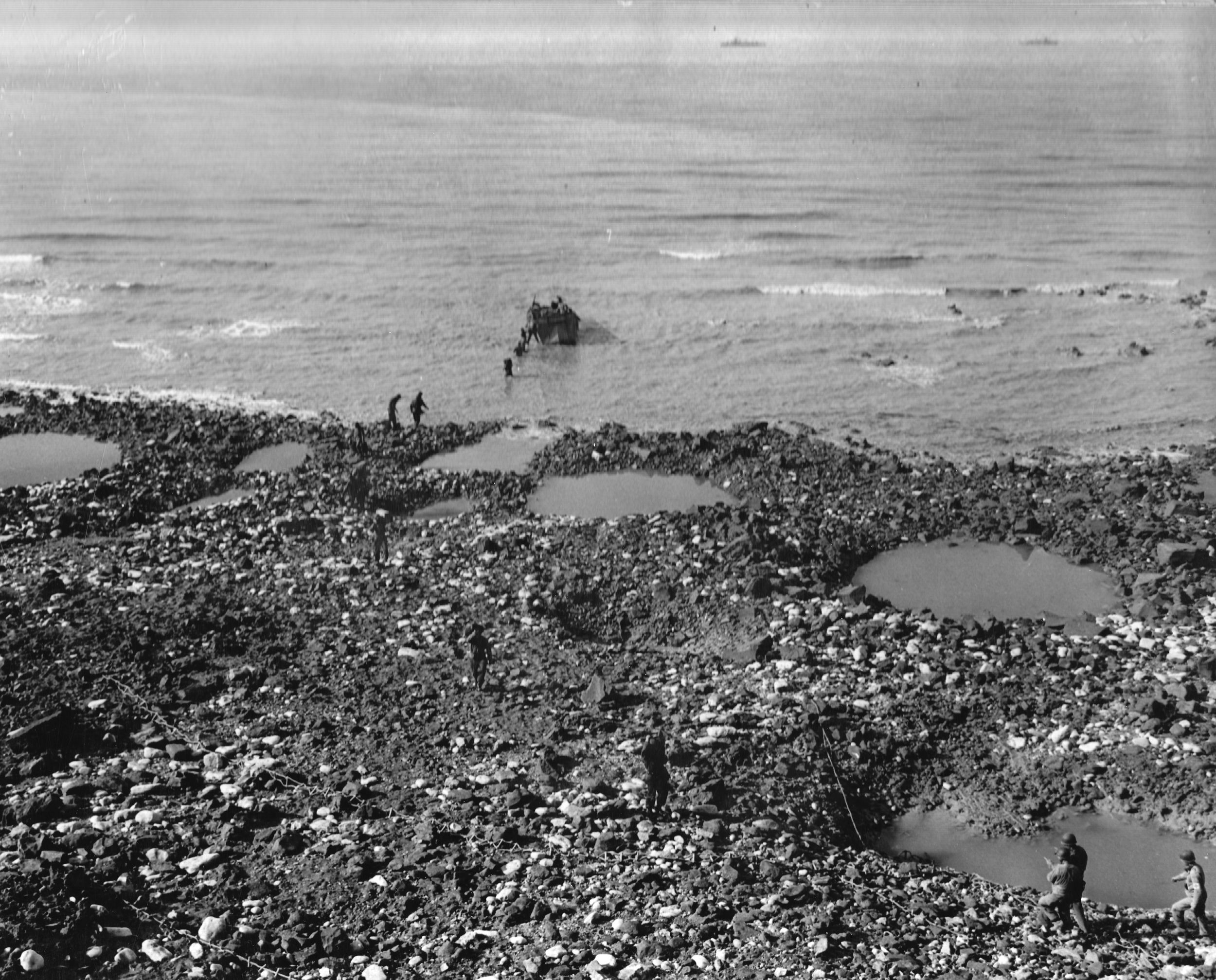
Ranger Sigurd Sundby looked inside the emplacement, which held a tangled bunch of wires. Unsure what the wires were for, he said to himself, “Well, I better cut them, just in case.”
Terrified by the battle going on around him, at that moment Sundby fell victim to the call of nature. “I must have gotten scared, because I had to take a crap, so I pulled my pants down. I took a crap,” he explained.
In a textbook example of Ranger tactics, the men, acting on their own initiative, broke up into small groups to achieve their objectives. Sundby separated from Lomell and his small group and emerged from the gun emplacement, bumping into Sergeant Richard J. Spleen. A strong, silent type who “kept to himself,” Spleen spotted two Germans firing upon them.
“I see two of them,” Spleen said to Sundby. Spleen leveled his M1 Garand at the Germans and “shot up the two Jerries.” But they managed to flee into the labyrinth of tunnels connecting the bunkers atop Pointe du Hoc, disappearing into the moonscape.
Another officer then shouted at the two men to go after several snipers who were picking off Rangers on the face of the Pointe. Spleen pointed in the direction of one sniper and the two men split up. Sundby attempted to flank the German by moving around a small knoll.
As he did so, he saw two men from Fox Company behind their machine gun. Sundby approached the weapon, but saw that the gunner had been shot right between the eyes. The other man had been killed, too. “He must have put his head up, and they got him,” thought Sundby.
At that moment, Sundby realized that he was standing, making himself an easy target for the snipers. A bullet snapped by his ear as he lunged to the ground.
He landed in a depression that provided cover from the sniper’s bullets. Moving forward, he found that he had crawled right into a morass of manure. “You know what it was? It was the darn settling pond where they must drain out the manure for the liquid to fertilize their fields,” Sundby remembered. Coated in the cow dung, Sundby ran for better cover.
Someone hollered, “Get down!”
Another bullet passed close to his ear.
“And this time I saw it come through a little tree right in front of me,” Sundby said, “and I saw the bark snap out. Then I dove down after that. I crawled away, and I got up on the hedgerow again. And I had kind of an idea where the bullet, what direction it was coming from, so I got up there and put my rifle in there, and got behind some brush—it was kind of a bush there. And I was just looking out there, and I couldn’t spot that sniper.
“But I figured, I saw a tree out there, and I thought maybe he’s up in that tree. So I kept my eye on that. I didn’t fire any shots right then because I thought he would move or something, so I could see him. Then I couldn’t shoot. So I waited there.”
While Sundby was pinned down, Lomell’s small group moved toward gun emplacements five and six. Again, the 155mm guns, the focus of their entire mission, were not in their emplacements. Here, too, Lomell noticed the Germans had replaced the steel barrels of the actual guns with telephone poles. At first glance, it seemed the Rangers had undertaken the mission for naught. Where were the guns?
At this point, Lomell had gone through three emplacements without finding any guns. He said to himself, “Jesus Christ, there’s no guns here. They gotta be somewhere.”
Avoiding the insistent 37mm fire, Lomell dashed for another shell hole. In the crater crouched about a dozen men from Dog Company, including men from George Kerchner’s 1st Platoon; Germans in nearby bunkered positions and farm buildings were giving the Dog Company men hell. Several men fixed bayonets on their M1 Garands, planning to make an over-the-top, World War I-like charge. Lomell remembered, “We were gonna charge across. We were gonna come out the shell crater as fast as we could and hit those encasements and see what the hell was there.”
Staff Sergeant Morris Webb was one of the first out of the hole. “Webb jumped the gun,” remembered Lomell. After ducking rifle and machine-gun fire, Webb dove back into the crater—and directly onto the scalpel-like steel of another Ranger’s ten-inch bayonet. It impaled Webb’s thigh, digging deep into the muscle. Lomell treated Webb, sprinkling sulfa powder on the fresh wound and throwing a bandage on it.
“Webb, you stay here,” barked Lomell.
The charge across Pointe du Hoc had been costly. In the process of moving from one shell hole to another and avoiding German fire, Lomell had lost half of his men—some only wounded and some dead.
Despite the losses, Lomell knew he must complete the mission. “Our mission and the mission of the 2nd Ranger Battalion, D, E, and F Company, was to get up on those cliffs and destroy those guns. The next part of our mission was to establish a roadblock and prevent any vehicles coming from the east with Germans toward Omaha Beach. The third part was to cut off any communications that we could and hold the line.”
The men separated into small groups, each trying to accomplish their primary objective of destroying the guns. Their search for the guns developed along three axes. About a dozen men from Dog Company, led by Len Lomell, moved from gun position number six toward the coastal highway. Fox Company paralleled them on the eastern side of Pointe du Hoc. Another pocket of men, led by Sergeant Frank Rupinski of Easy Company, advanced down the middle between the other two groups.
En route to the coastal highway, First Sergeant Lomell and his men knew they had to overcome several bunkered buildings that served as German crew quarters. From his training and his memory of photographs presented at various briefings, Lomell remembered that the Germans had mined the entire area. The Rangers would have to traverse these dense minefields. In addition, the 37mm antiaircraft gun on their right flank was tearing up the area around them, putting up a lot of fire.
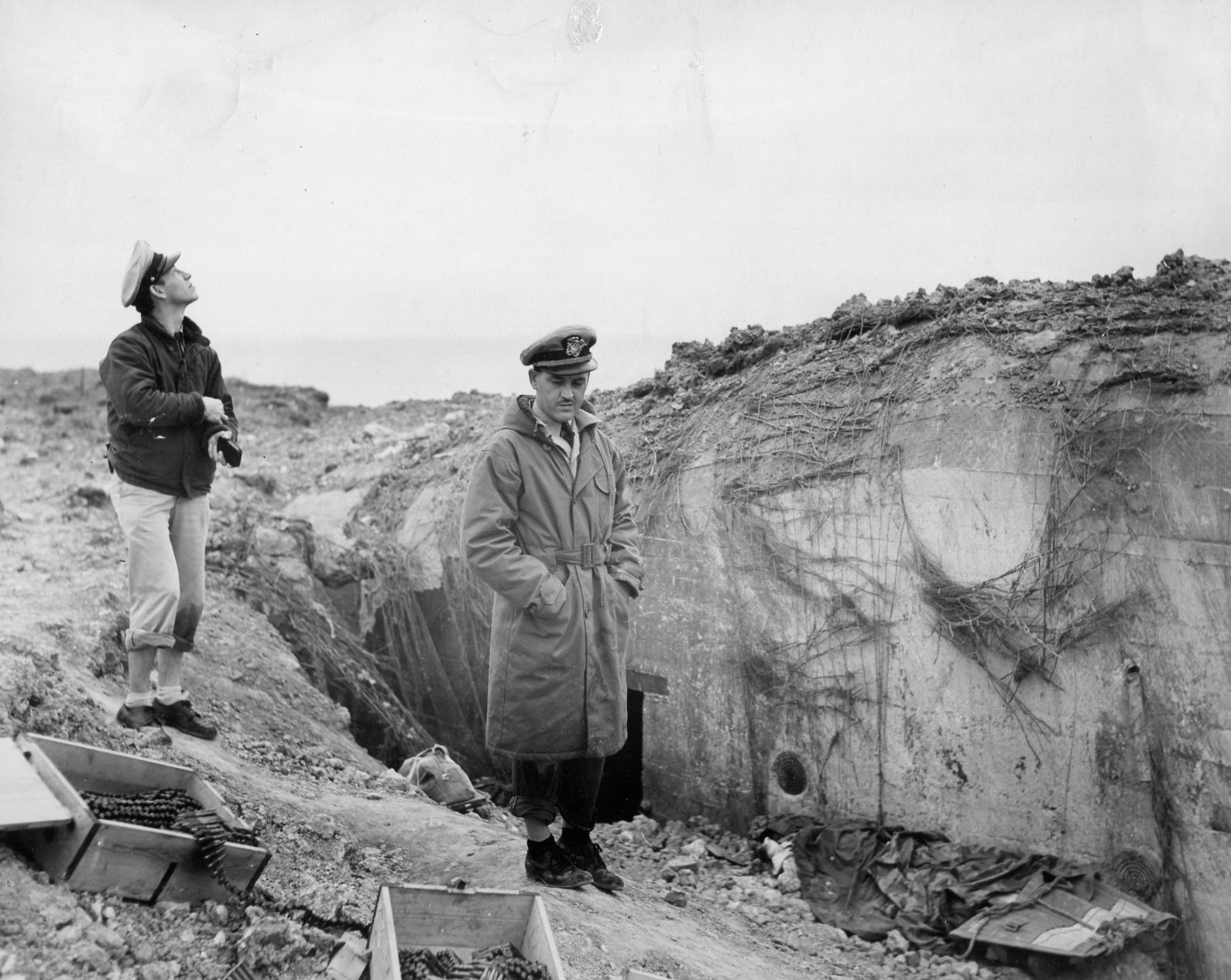
As the Rangers advanced upon the bunkered position, Lieutenant Ted Lampres and a couple of E Company men approached Lomell. “What are you doing, Len?” Lampres asked.
“What I’m gonna do is move up and throw a bazooka into them and blow the whole God damn thing up,” Lomell replied, moving the bazooka into position. Unfortunately, the loader forgot to pull the pin on the bazooka round, and it failed to detonate.
Meanwhile, the antiaircraft gun bore down on Dog Company. “The son of a bitch was giving us a really hard time,” recalled Lomell. Lieutenant Lampres and several men moved off to the right flank to try to take out the AA gun.
From the shell hole, Lomell and his men studied the crew quarters. “We’re gonna hit ‘em hard,” Lomell told his men.
The Rangers charged. “We were hooting and hollering, yelling ‘EEAAGGHH!!’ We wanted to scare the shit out of them,” recalled Lomell.
The Americans attacked the quarters, firing their Thompsons and M1s into the buildings. Many of the Germans were unarmed, dashing for their weapons as they were putting on their shirts and uniforms. While some of the enemy fought back tenaciously, others ducked into underground tunnels.
As the Rangers pushed inland in pursuit of the enemy, a creeping artillery barrage exploded behind them.
Lomell’s men charged forward to the coastal road with a deadly rain of steel at their backs. The first sergeant’s small group included his best friend, Staff Sergeant Jack Kuhn. The two best friends each led a column of men, one on either side of the sunken road. The men soon came across a centuries-old stone barn.
Suddenly, Lomell grabbed Kuhn’s arm, threw him into the doorway of the Norman barn, and rushed inside himself. Kuhn was startled. “Why’d you do that?”
“Didn’t you see that Jerry kneeling on the road, aiming at us?” Lomell asked in amazement.
Kuhn peeked around the doorway. Two German rounds barely missed the Ranger sergeant.
Lomell poked his tommy gun through a window of the barn and fired at the Germans. He missed. Kuhn went to fire his tommy gun, but a bullet had struck the ammunition clip where it inserted into the weapon, rendering it useless.
Meanwhile, elements of George Kerchner’s 1st Platoon came up the side of Pointe du Hoc with Rudder’s command group. The 37mm gun continued taking its bloody toll, while small bands of Rangers made their way toward the projected gun positions.
The Germans counterattacked, emerging from craters and trenches and the rubble of Pointe du Hoc. Similar to a game of whack-a-mole, Germans began popping up all around the maze of ruined trenches and underground shelters and bunkers. For the Rangers, the pockmarked surface of the Pointe made it difficult to distinguish friend from foe.
Kerchner rounded up most of his 1st Platoon along with other members of Dog Company. The German AA gun continued to fire at his group while 1st Platoon tried to take it out with rifle fire. Pinned down, they had difficulty even getting a shot off.
In an attempt to flank the gun, Kerchner jumped into the communication trench. “I was by myself at this time, and I have never felt so lonesome before or since in my life because every time I came to a corner in this communications trench, where I had to make a turn to see what was in the next 25-yard section, I didn’t know whether I was going to come face-to-face with a German or not.”
Kerchner stooped low as he darted through the trench. His loneliness gave way to sadness when he caught sight of Bill Vaughan, one of Lomell’s climbing “monkeys.” The Ranger officer related, “I realized as soon as I saw him that he was dying. He had been practically stitched across with a machine gun. He wasn’t in any pain because he was hit too bad. I knew he was dying.”
The lieutenant from Baltimore approached the mortally wounded Ranger and compassionately told him, “Bill, we’ll send a medic to look after you.”
Kerchner continued skulking cautiously through the trench, eventually meeting up with the rest of his men, much to his relief. Together, they found their way through the labyrinth until it emptied out near the ruins of a farmhouse. Finally out in the open, 1st Platoon pushed on toward the coastal road, their secondary objective.
When Dog Company sergeants Bill Cruz (who had been hit in the arm on the beach before scaling the cliffs, but, like many of the Rangers, he carried on in spite of the pain) and William Robertson reached the top of Pointe du Hoc, they ran into Lt. Col. Rudder. Despite also being wounded, Rudder’s charismatic presence inspired the men around him.
The men were told to guard the area that Rudder had designated as his new command post, but the persistent crack of deadly sniper fire filled the air around them.
Sergeant Cruz and another Ranger fired at the sniper, but missed. Suddenly, machine-gun and antiaircraft fire from the 37mm opened up. Rudder looked at both men and said, “Go after it.”
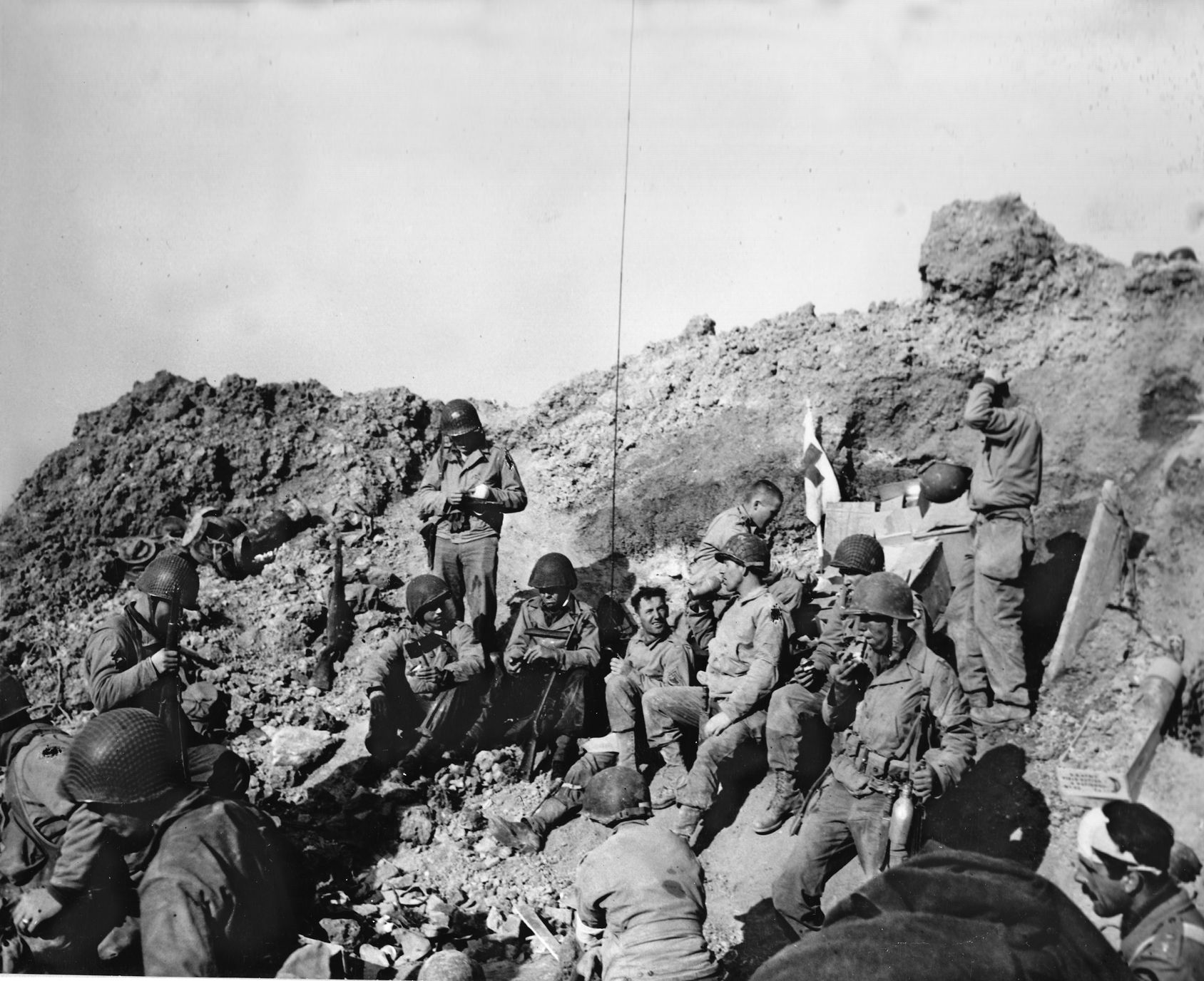
Whenever the Rangers opened fire, artillery rained down on their heads. As they crawled forward through the countless shell craters, they came upon approximately 10 men pinned down near gun position number six, including Richard J. Spleen of D Company and Harold D. Main of E Company. Together, the Rangers held their fire “for fear of drawing 88 fire.”
The small group crawled west in an attempt to get a better position on the German machine-gun nest and the AA gun. Cruz spotted a German soldier waving a helmet on a rifle, attempting to draw the Rangers’ fire and expose their positions. “Somebody [in our group] came up from behind and unwisely fired on this decoy. Right away, 88 fire and mortar fire hit.”
Because the men were bunched up in the craters, they took off in different directions to avoid being hit in one group. When the men separated, Cruz found himself alone in the maze of tunnels and craters. He yelled out, “Is anybody there? Is everybody all right?”
Sergeant Main responded, “[We’re] OK.”
Cruz waited for 15 minutes. Small-arms fire crackled in the distance. The Ranger NCO started crawling back across a crater and took fire from snipers. He reached a trench near gun position six, where he spotted Spleen, who was recently separated from Sundby, and two other men in a trench right nearby. “All the sudden, [a] lot of firing, machine guns and machine pistols … [began hitting] close to the west. He saw Spleen’s men throw down their guns out of the trench they were in, surrendering.” Cruz kept quiet, hugging the ground.
“The firing died down and after the first few seconds, he saw no one. Later, crawling out back toward the command post he passed a pile of weapons, lying on the ground near gun position number six—eight or nine rifles, some pistols, and four Thompsons.” Later, the Rangers found some of the packs from the captured group. Cruz was the sole survivor.
Another Ranger also found himself alone. Bill Hoffman was the only Ranger in an underground bunker atop Pointe du Hoc. “I managed to get over to a bunker, not the one I was supposed to be in, but I got in there. They were shelling us pretty good. Inside the bunker things got quiet.”
Hoffman ended up in a room full of German bicycles, where he considered his next course of action. “I was sitting there trying to make up my mind when I heard this God-awful explosion in the corridor between the rooms. It scared the hell out of me.” “What is that? What am I gonna do?” Hoffman wondered.
After a second explosion, Hoffman threw one of the bicycles out into the hallway. Seeing fins from a bazooka round nearby, he thought, “Oh, my God, they have our equipment!” Suddenly, a voice barked out, “Come out with your hands up!”
“Geez, they speak really good English,” Hoffman thought. After sticking his hand out into the hallway to make sure they weren’t planning to shoot, he slowly emerged. In front of him stood an American lieutenant and a sergeant, who was holding a grenade.
“Hey, Sarge! What are you going to do with that?” asked Hoffman.
“I’m going to roll it right down that hallway,” replied the sergeant.
“What are you doing in here?” the lieutenant asked Hoffman.
“I’m getting out of the artillery fire.”
“We got word there were Germans in here,” said the lieutenant.
“There are no Germans here, just me,” Hoffman replied.
Bleeding and exhausted from climbing and fighting through the trenches, First Sergeant Lomell looked at his remaining men and said, “Follow me.” The firefight in the farm buildings had taken its toll.
Still, Lomell led the most sizable force on top of Pointe du Hoc. The small band headed along a dirt road that led to the blacktop coastal road. (In 1944, the coastal road was called GC32. Today it is known as D-514.) The men made their way towards the intersection. Abruptly, a wall of small-arms fire enveloped the Ranger patrol. Jack Conaboy, one of Lomell’s platoon sergeants, was flattened in the middle of the inter- section.
“Len! Len! I’m hit!”
“Where’re ya hit?”
“In the ass,” responded Conaboy.
“Well, get the hell over here,” said Lomell. With a burst of adrenaline, Conaboy jumped up and ran towards the ditch where Lomell and the others had taken cover. Conaboy dropped his pants, and Lomell inspected the wound. The bullet didn’t go all the way, through.
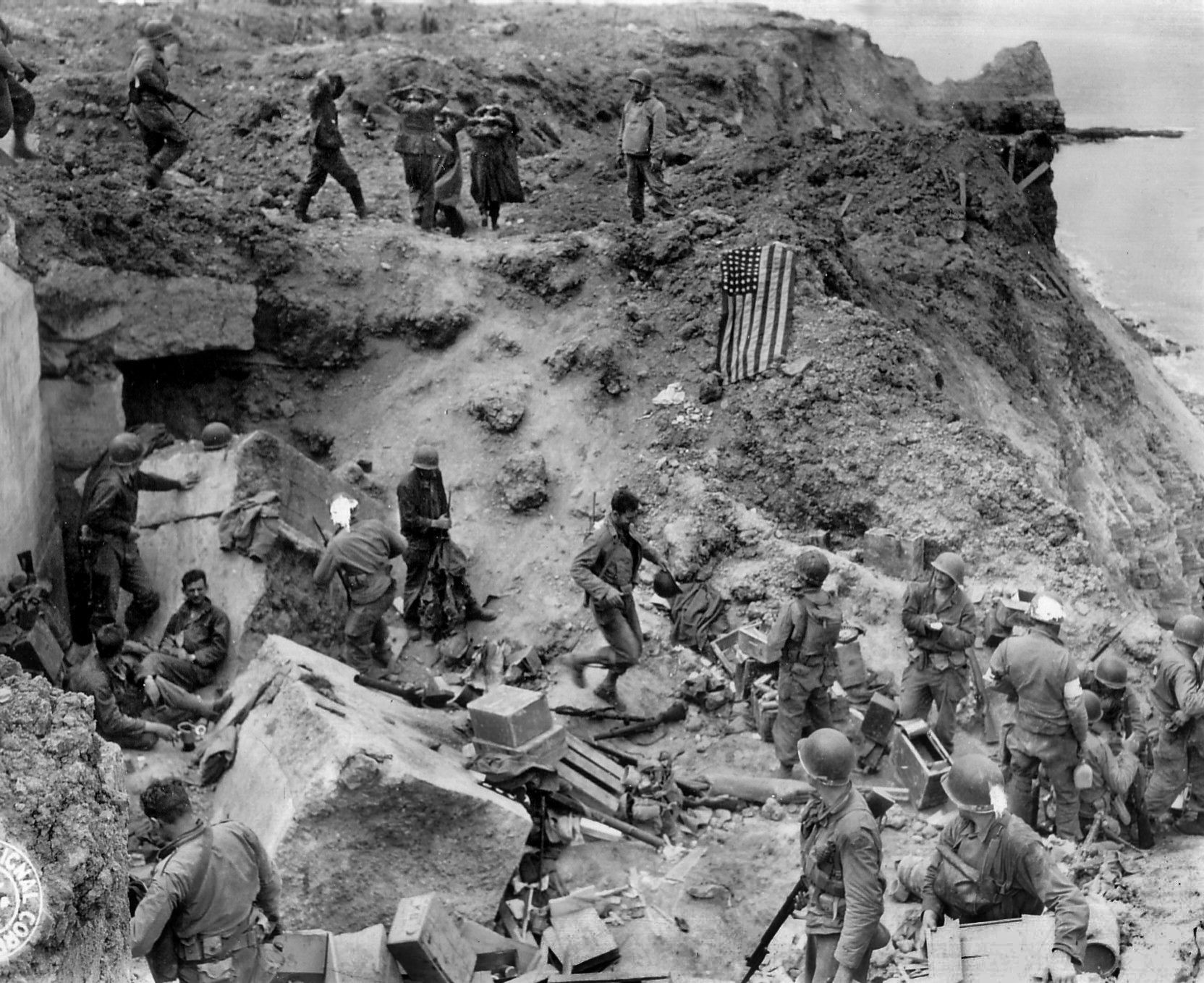
“You’re lucky; you’ve got a souvenir here.” Lomell pulled out the bullet and packed the wound with sulfa powder. After taking care of Conaboy, Lomell’s group cautiously made their way down the coastal road. Suddenly, Lomell and Kuhn spotted a platoon of about 35 heavily armed Germans. They knew engaging them would be suicide.
The men flattened themselves in the ditch as the Germans marched past. “Three men against 35 was stupid, and it would ruin our mission,” recounted Lomell. “So we let them pass.”
A stone fence paralleled the road. Suddenly, a German soldier appeared in an opening in the fence and looked down the highway. Not detecting the Americans, he ran across the road and right up to where Jack Kuhn was hiding. Kuhn jumped up and fired point blank with his tommy gun, hitting the German in his chest.
“My slugs must have cut the strap on his weapon, for it fell to the ground about three feet in front of me. The German ran a few steps and dropped.”
Johnson asked Kuhn to retrieve the dead German’s MP 40 submachine gun. As Kuhn attempted to grab the machine pistol, he saw another German soldier aiming at him. “I had no way to protect myself and felt I was about to be shot.”
Just then, bullets from Lomell’s Thompson ripped into the German, killing him, but not before one of the enemy’s bullets struck the road next to Kuhn, barely missing him. At this point, Lomell and Kuhn decided to have the men pair up and keep searching for the missing guns: “There’s a minefield on our left full of mines. ‘Well,’ we decided, ‘there’s nobody but us, so let’s split up into twos.’”
Lomell and Kuhn set off together and soon discovered tire tracks in the lane. Lomell realized that the grooves couldn’t have been made by a simple farm wagon—the impressions were far too deep. Something massive had crossed the earth. “We figured we ought to take a look.”
Lomell and Kuhn moved down the sunken road, which cut through several pastures and high hedgerows. “You could have hid a column of tanks in it, that’s how deep it was,” recalled the first sergeant.
The two Rangers carefully traversed the road, moving about 100 yards down the country lane. Lomell scouted out the position while Kuhn covered him, then the two men switched off, or “leapfrogged,” as they made their way deeper and deeper into German territory. Suddenly, Lomell and Kuhn came upon a picturesque, lush apple orchard.
“My God, there they are!” Lomell said to himself.
Lomell turned to Kuhn. “My God. Look at them. They’re ready to go.” The long, 155mm barrels of the guns of Pointe du Hoc loomed directly in front of them.
Five of the K418 guns—the German designation for the former French artillery pieces—had been towed inland and pointed at Utah Beach. They could easily have been turned around and used to fire upon Omaha Beach as well. Netting covered in fake leaves was draped over the five guns. But the sixth gun was mysteriously missing.
Amazingly, not a soul stood guard near the artillery. For over 65 years, historians have debated why the Germans failed to man the guns. The most plausible theory is that when the Rangers took out the German forward observation posts, they took out the German eyes on Pointe du Hoc, severing communication with the gun crews.
As Small Unit Actions notes, “All that can be stated with assurance is that the Germans were put off balance and disorganized by the combined efforts of the bombardment and assault, to such an extent that they never used the most dangerous battery near the assault beach but left it in position to be destroyed by weak patrols.”
The Germans could clearly see Utah Beach. It’s a mystery why they didn’t fire directly on that sector, even without official orders. However, they could see about 75 to 100 Germans assembling several hundred feet away in the corner of an adjoining field.
“The Germans were in various states of undress,” noted Lomell. “They were putting jackets and shirts on; they were being rallied. They were being talked to by some officer standing in his vehicle. This is now about eight in the morning.”
It appeared to Lomell that the group included the 35 heavily armed Germans who narrowly missed discovering him and Kuhn just minutes earlier.
Lomell asked Kuhn for his incendiary grenade, adding it to his own. With Kuhn covering him, Lomell climbed over towards the guns. Armed with only a submachine gun, his .45, and two thermite grenades, he moved into position near the artillery. He placed a thermite grenade on two of the guns. “The thermite grenade was special for this type of action because we were going to lay them on the moving parts of the artillery and destroy the movable gears in the guns.”
Lieutenant Lomell pulled the pins. POP! A molten, metal-like substance flowed over the parts, seeping into the crevices and welding them together so that they were inoperable. Remarkably, the nearby Germans didn’t detect the first sergeant.
Kuhn wrapped his field jacket around the butt of his tommy gun, using it to smash the sights of all five artillery pieces. “I didn’t know if I was going to get back, so I wanted to do as much damage as possible.”
Lomell and Kuhn’s actions—the actions of two men who were willing to risk their lives for the mission—had a profound impact on the entire invasion.
Not thinking about anything other than the mission, Lomell scurried back over to Kuhn and whispered to him, “We’ve got to get more grenades.”
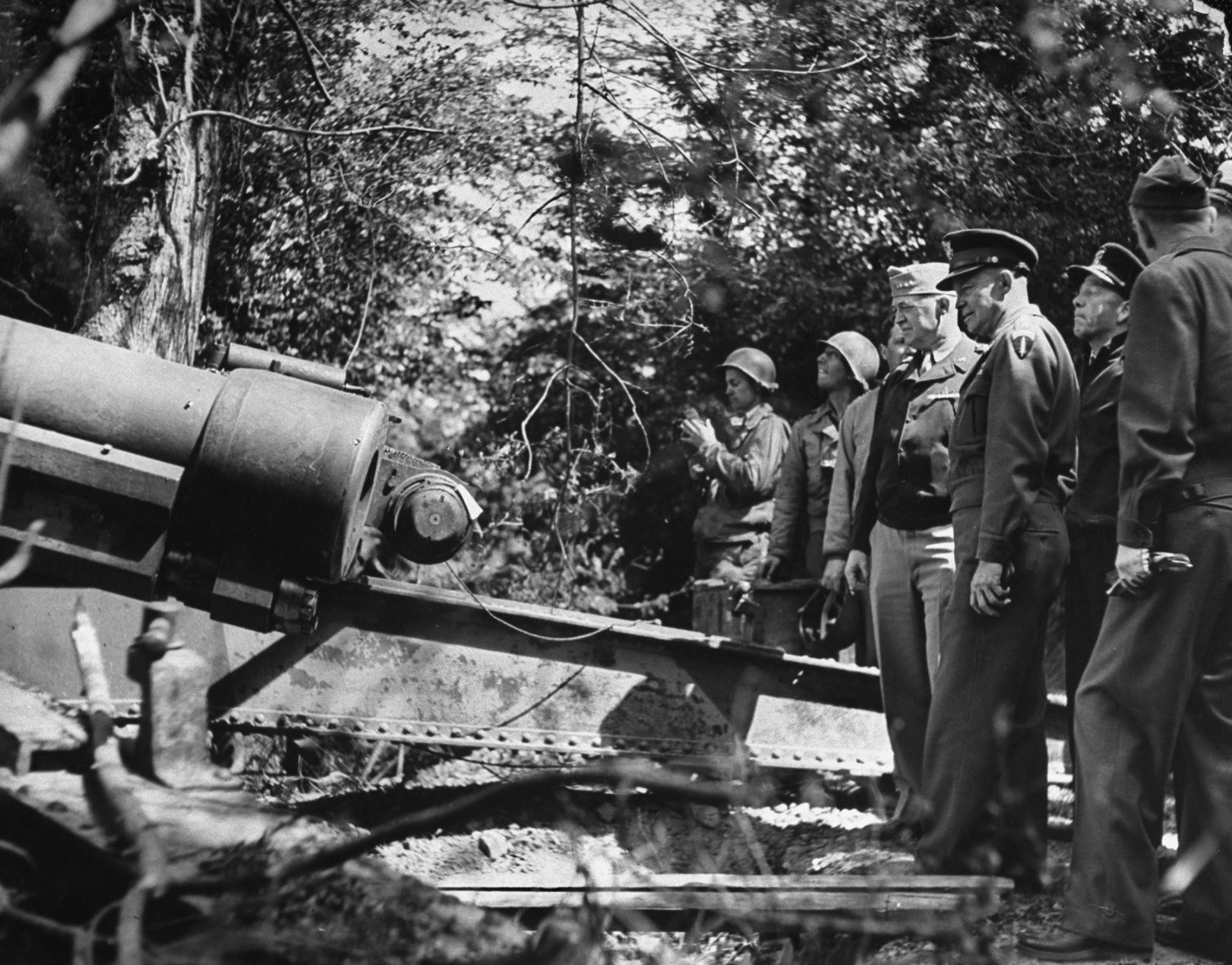
Kuhn and Lomell dashed back a hundred yards or so down the road, where they met other men in their platoon and asked for their incendiary grenades. With his field jacket full of incendiaries, Lomell ran back towards the guns with Kuhn at his side.
When they reached the guns, Kuhn trained his Thompson on the Germans in the field. The first sergeant placed thermite grenades on the three remaining guns. As Lomell finished rigging the last field piece, Jack said, “Hurry up! Hurry up!”
After pulling their pins, Lomell scrambled over a nine-foot-tall hedgerow, where Kuhn was standing.
Then “the whole world blew up,” as Lomell and Kuhn flew off the hedgerow and onto the sunken road. “Dust and the stones and the brush came out of the sky. Ramrods and all kinds of things fell around us.”
“What the hell just happened?” asked Lomell. Unbeknownst to the two men, Sergeant Frank Rupinski from Easy Company had detonated an ammunition store near the guns, causing a massive explosion. (Rupinski had led a patrol from E Company and advanced on the guns from the east. Accounts differ, but besides blowing the ammunition store, his group may have placed grenades in the barrels of the guns after Lomell had already disabled them.)
It was now approximately 8:30 am. Two Dog Company Rangers, Leonard Lomell and Jack Kuhn, had achieved what scores of bombers dropping hundreds of tons of bombs, and the massive 14-inch guns of the battleship Texas, as well as a constant bombardment from off-shore destroyers had failed to achieve. Thanks to them, five of the six guns of Pointe du Hoc would never fire again. (After locating the sixth gun nearby, a patrol from Easy Company soon eliminated it.)
Rejoining the other men, Lomell dispatched two volunteers to relay the news that they had accomplished the mission. Ironically, he chose Private Harry Fate, the man he accused earlier of shooting him in the side. Sergeant Gordon Lunning accompanied Fate.
Going back through the country roads, traversing the moonscaped surface of Pointe du Hoc, Lunning and Fate fought their way back to the German bunker that Rudder had converted into a command post. The runners from D Company arrived at the command post at approximately 9:00 am, where Lunning encountered Lieutenant James Eikner and told him the news. Eikner then informed Rudder. “Should I send a message, sir?” Eikner asked.
“Yes,” Rudder answered.
Most of the Rangers’ radios had been waterlogged or damaged in the landing. Astutely planning for such a contingency, Eikner had brought along a signal lamp. Luckily for the Rangers, Eikner was trained in Morse code and sent off the pre-designated signal to confirm destruction of the guns: “Blow Six.” The lieutenant also requested resupply and reinforcements.
As the final contingency, in case all the technology failed, Eikner relied on the wings of a carrier pigeon to relay the message. Slipping a small note inside a tube attached to the bird’s leg, Eikner released it. Initially, the winged messenger failed its duty miserably, repeatedly circling the command post. Eikner threw pebbles at the bird until, finally, it flew towards the Allied fleet.
An hour later, the destroyer USS Satterlee responded: “No reinforcements available—all Rangers have landed on Omaha.”
Like Lomell and the rest of the men on top of Pointe du Hoc, Rudder and the others in his command post were on their own, and tragically, the guns of their comrades would pose the greatest danger.
Several forward artillery observers, including Private Henry Genther and Navy Lieutenant Kenneth “Rocky” Norton, had accompanied the Rangers. Using Eikner’s signal lamp, the men now called in artillery from the nearby Allied warships. They also called in a strafing run from P-47 fighter-bombers. The Thunderbolts arrived first, and the lead plane mistakenly began a deadly dive-bombing raid directed toward Rudder’s command post.
Quickly, Eikner spread out an American flag along the side of the cliff. Spotting Old Glory, the American pilot waggled his wings and flew off toward the German positions across Pointe du Hoc.
The shore-fire control party then used Eikner’s lamp to call in naval fire upon the German machine-gun nests and the 37mm AA gun that was wreaking so much havoc on them. But an artillery shell from the battleship Texas’s 14-inch guns landed short, detonating near Rudder’s command bunker. The shell killed Captain Jonathan Harwood and Private Genther, also wounding Lt. Col. Rudder and Lieutenant Norton.
The fatal round was like an armor-piercing shell containing yellow pigment known as “Explosive D” or Dunnite. A soldier said, “The men were turned completely yellow. It was as though they had been stricken with jaundice. It wasn’t only their faces and hands, but the skin beneath their clothes and their clothes which were yellow from that shell.”
Bill Hoffman recalled seeing one of the men killed by the shell. “He had no head and no blood. He was covered with yellow dye. The shrapnel just took his head off, nice and clean. He was all yellow. I said to myself, What the hell is that? It was my first introduction to death in the war.”
Already wounded in the leg, Rudder was wounded again by the yellow marker shell. Despite his wounds, he refused to relinquish command and continued leading his men.
After Eikner sent out “Praise the Lord,” indicating success, Rudder instructed Lunning and Fate to take a message back to Lomell’s group, which had set up a roadblock—the second part of their mission.
Rudder’s orders were simple: “Hold ‘til duly relieved.”
Reprinted from Dog Company, by Patrick O’Donnell. Available from Da Capo Press, an imprint of the Perseus Books Group. Copyright © 2012.
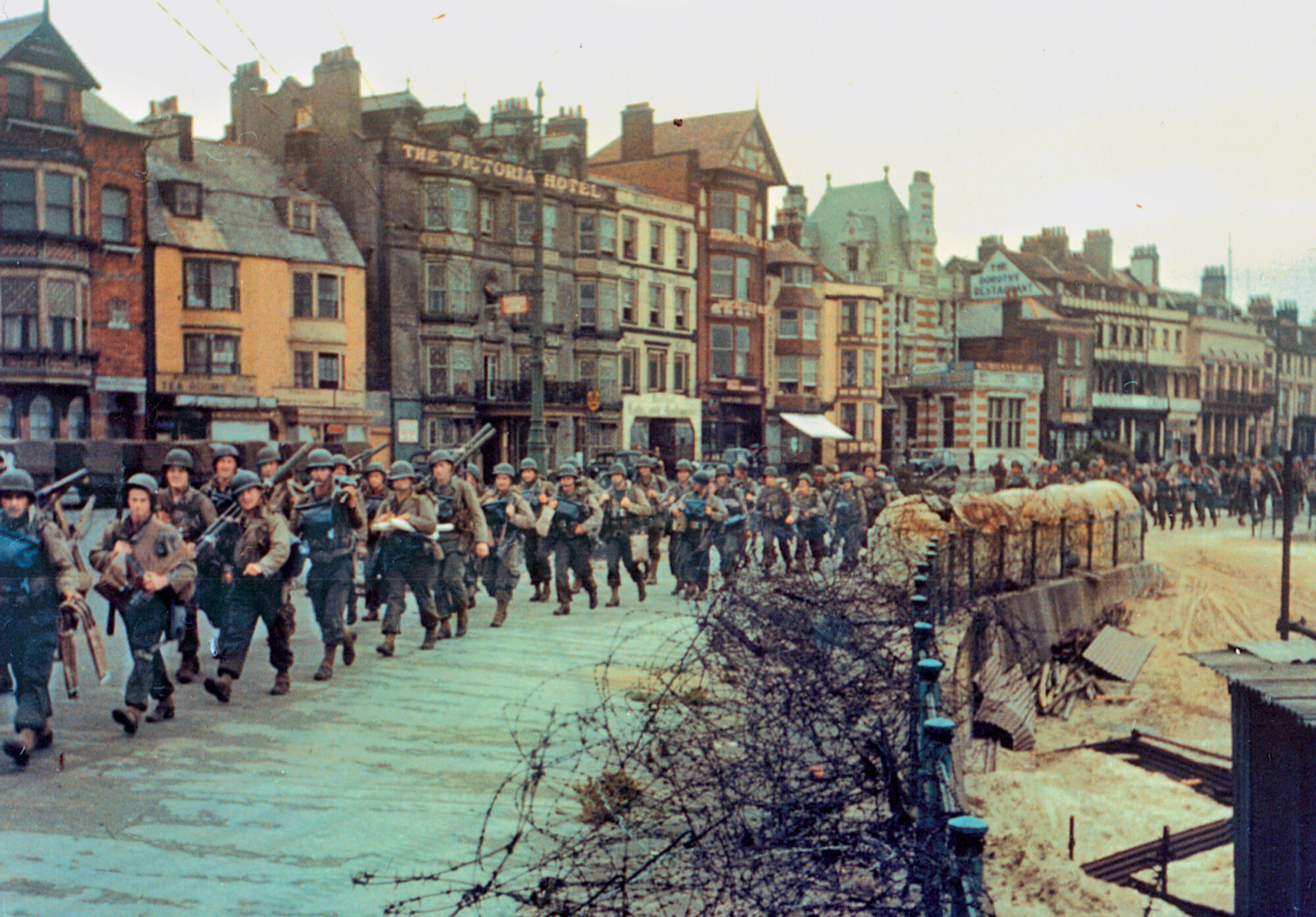
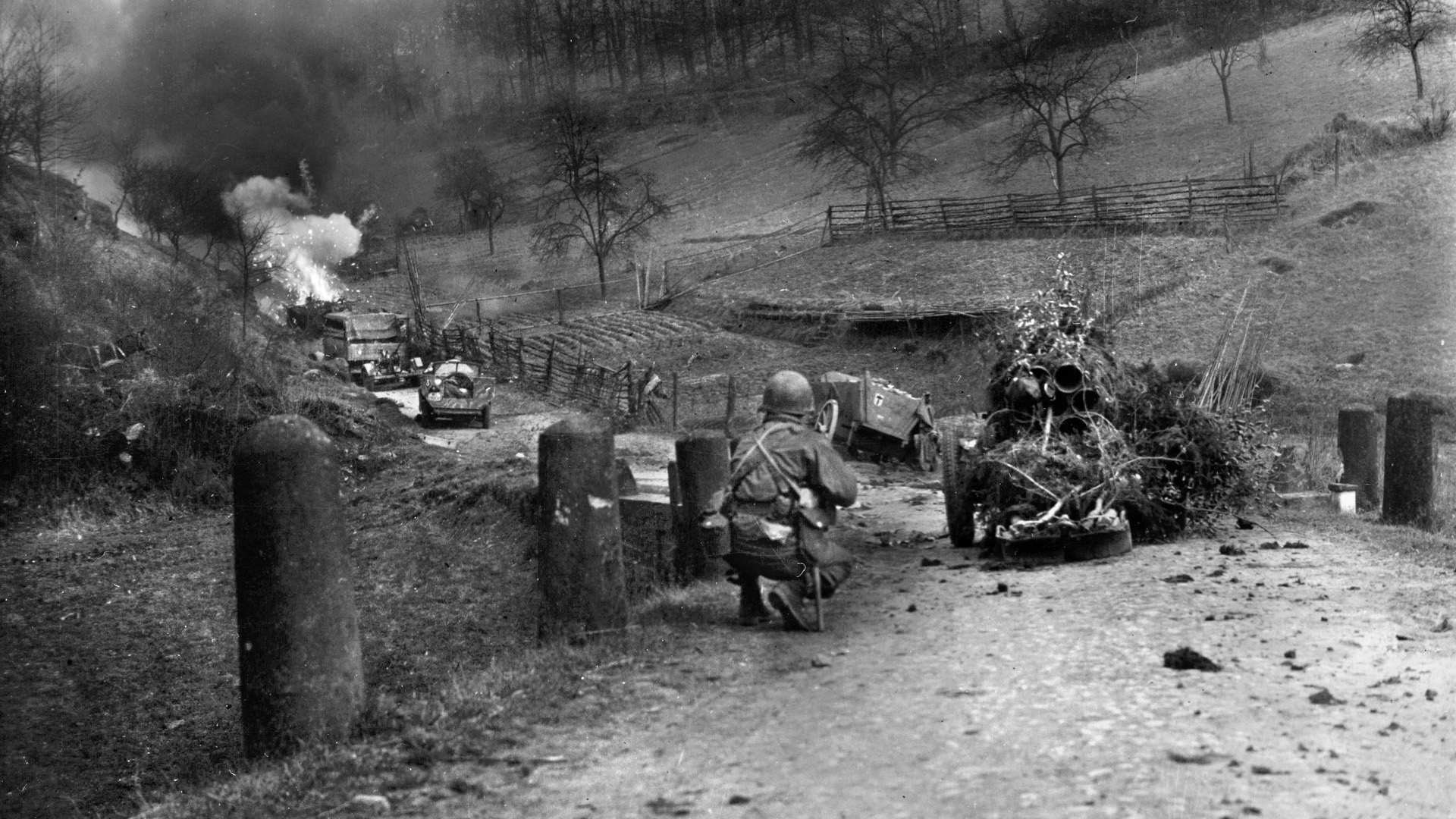
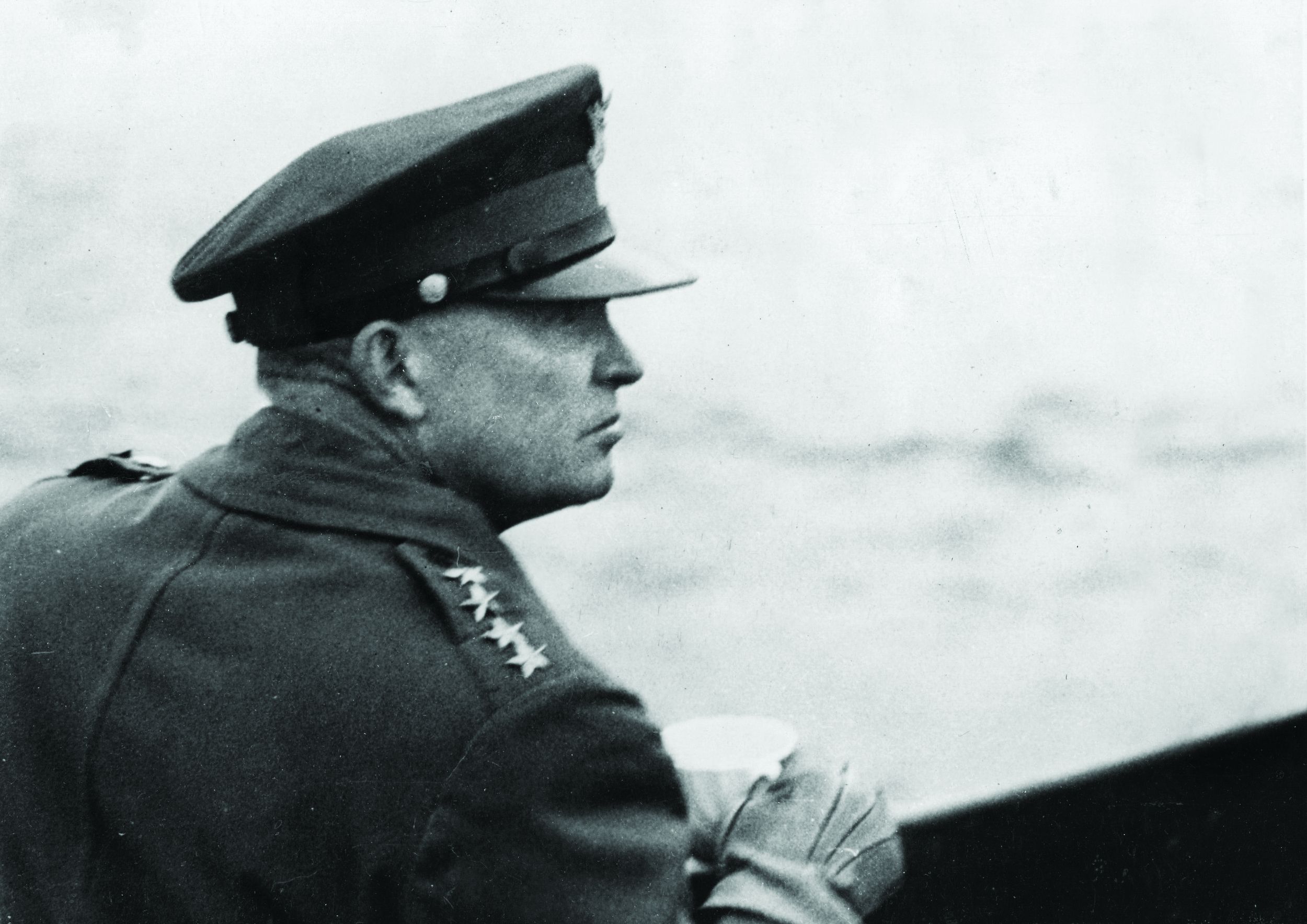
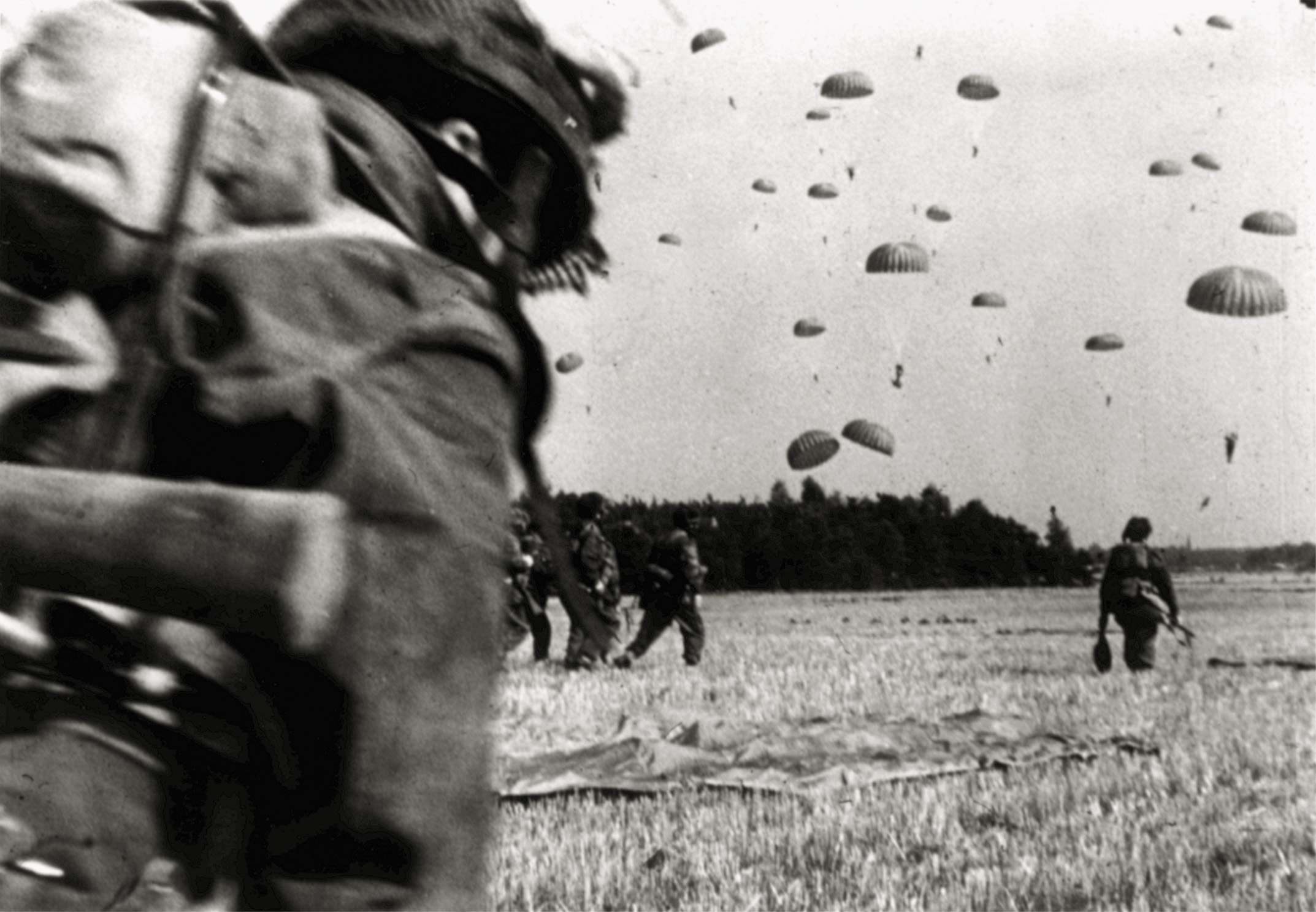
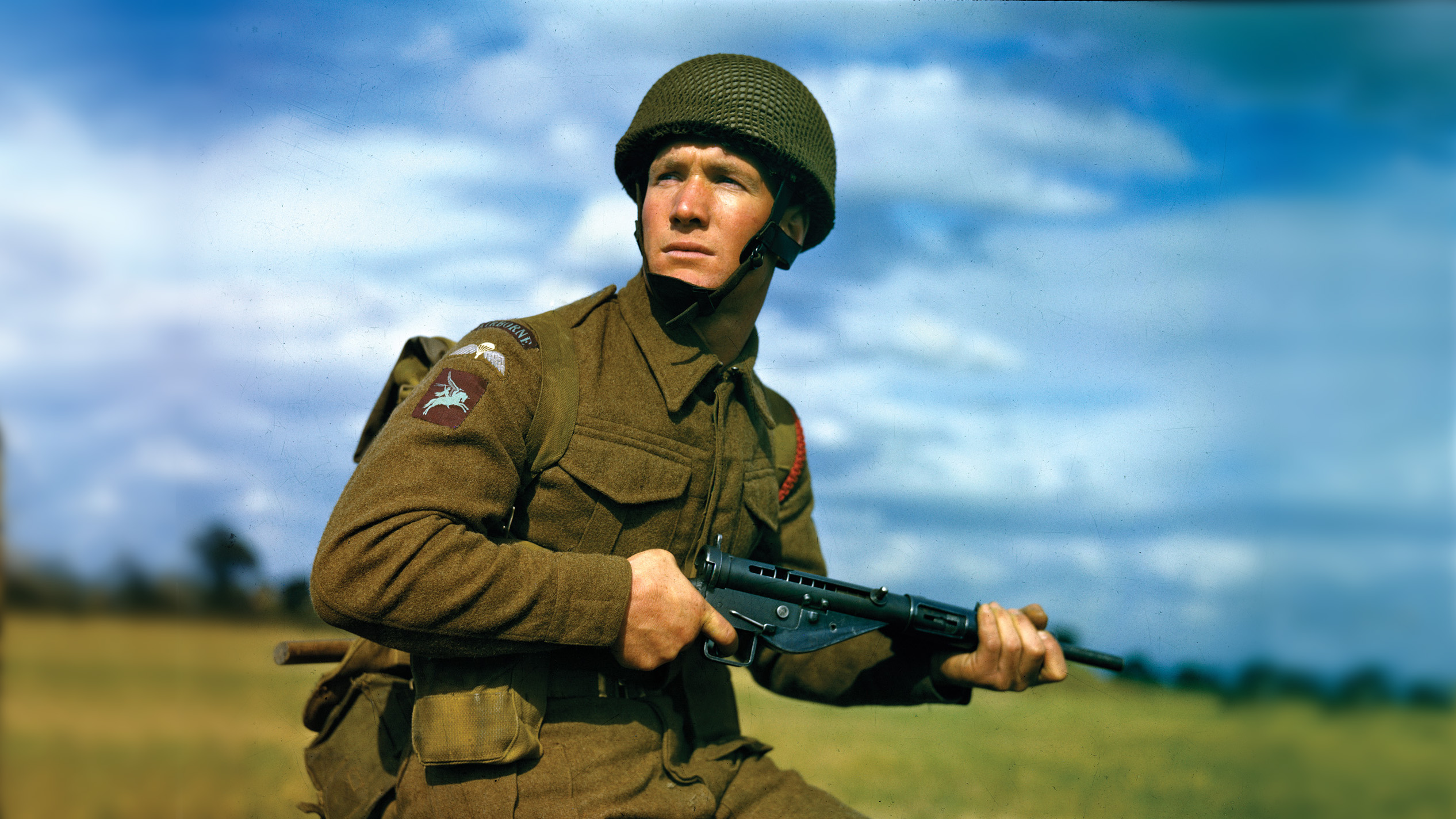
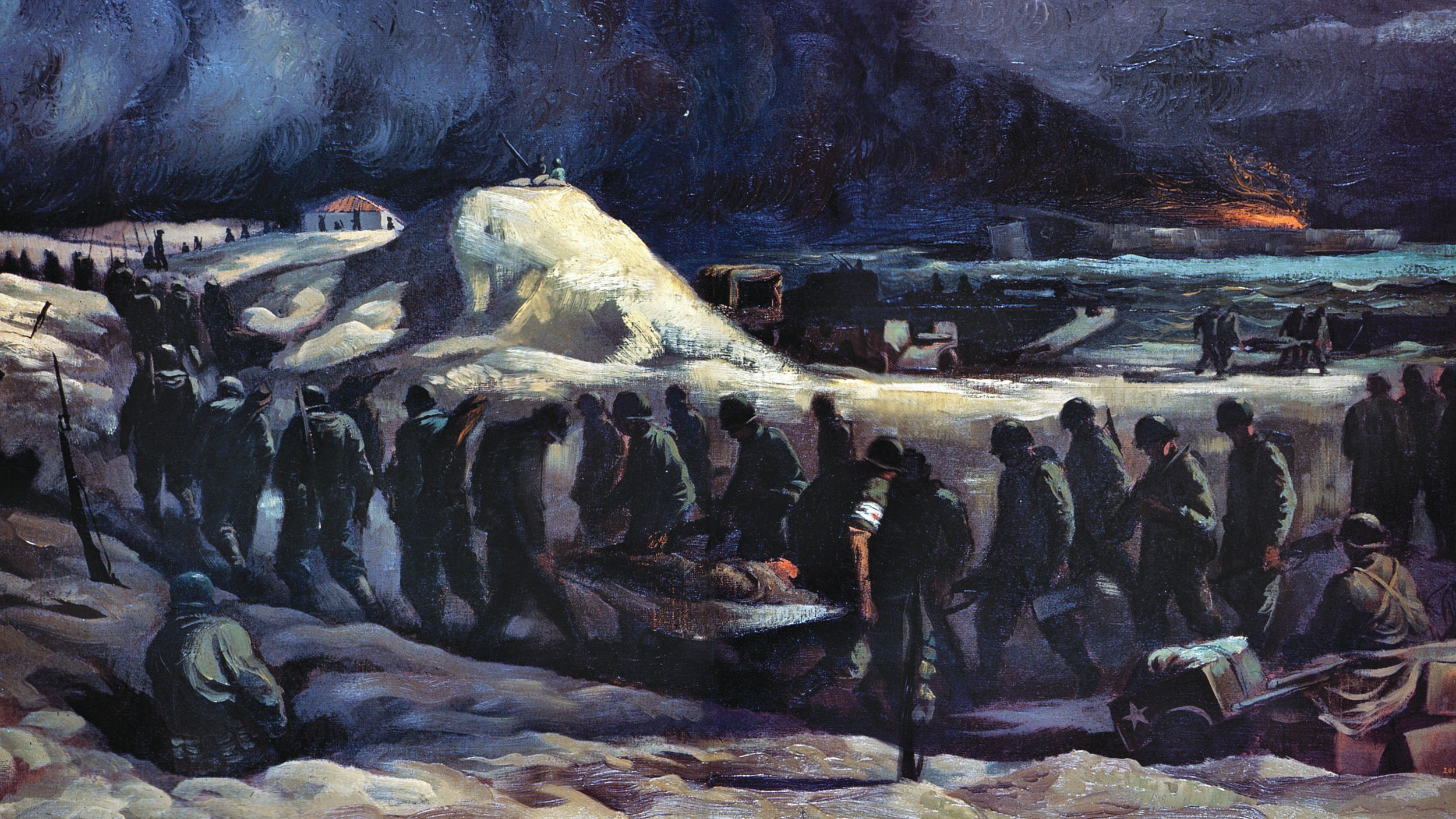
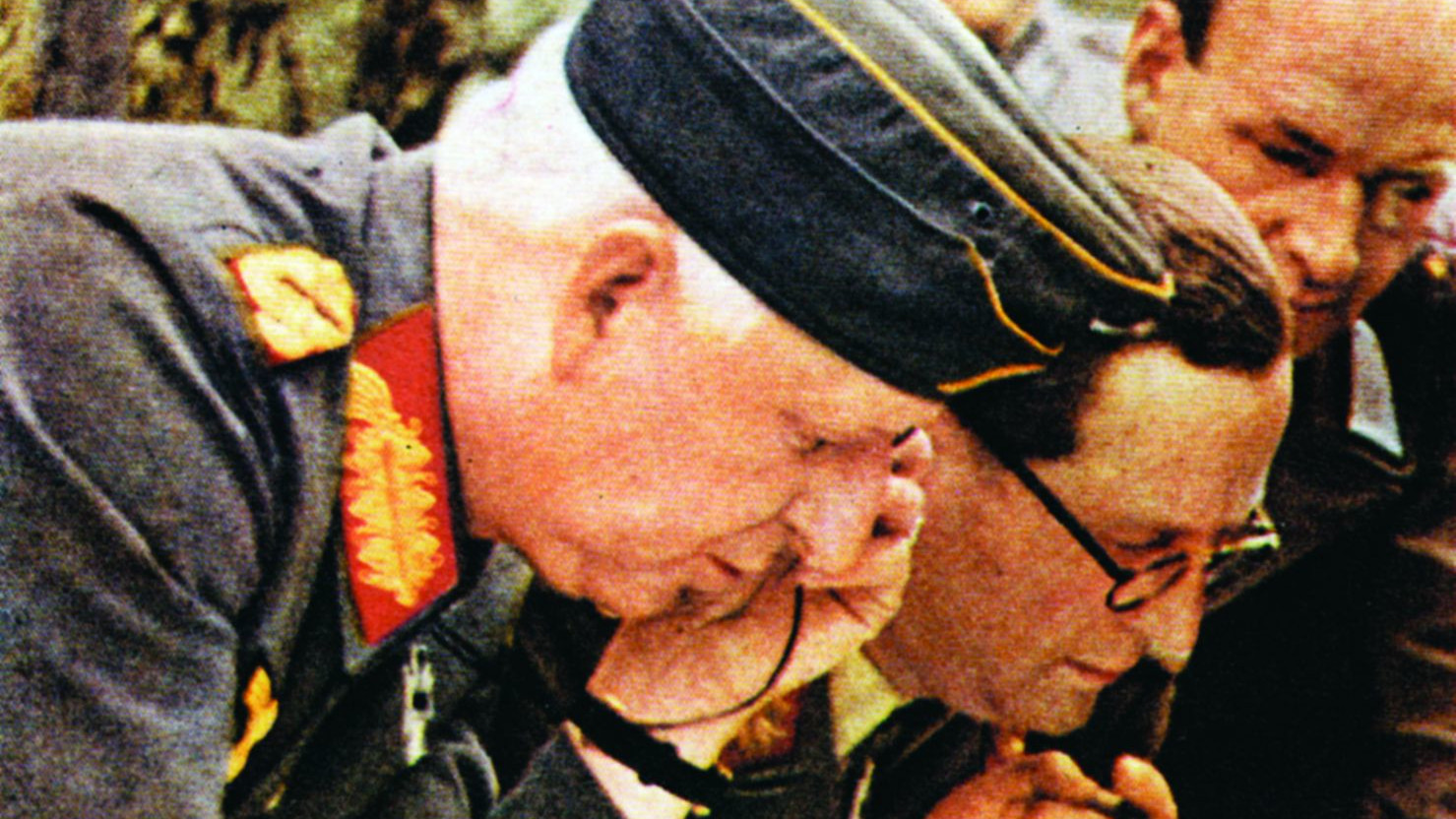
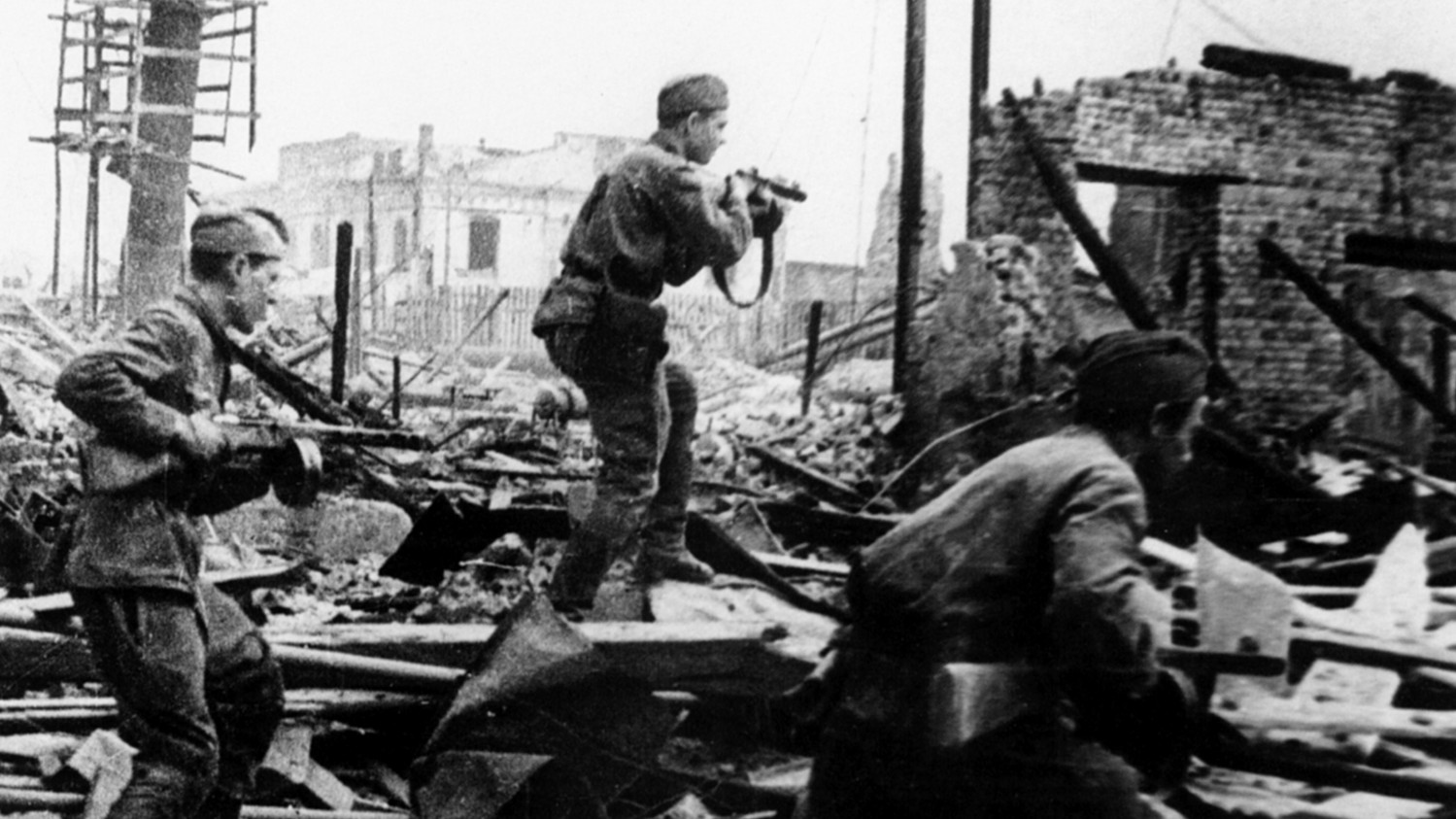

Join The Conversation
Comments
View All Comments